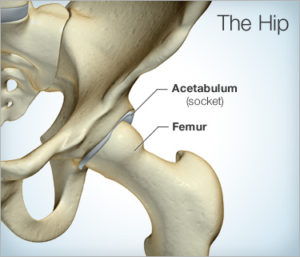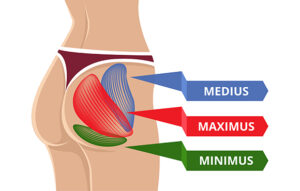In this blog we’re going to look at why hip stability and mobility are so important and their relationship to injury prevention. Let’s start with a quick overview of the hip joint……
The hip joint consists of the acetabulum of the pelvis which forms the socket, and the head of the femur (thigh bone) which is the ball. These two bones are held together by various ligaments, muscles, and tendons. The hip joint is a very stable joint (compared to others joints in the human body) because the socket is deep, which enables the head of the femur to sit securely in it.

We need to have enough mobility in the hip to run effectively – internal rotation is required to allow the hip to extend whilst running. Hip extension is a crucial part of the drive phase of running and if any of the muscles that flex the hip become too tight and shorten then they will limit this movement. The mobility of the hip will become impaired if there’s not enough stability within the joint and vice versa, this can also lead to energy leaks and injury further down the chain (knee, ankle, and foot). Muscles that play a key role in the stability of the hips are the gluteals.

The gluteus medius and minimus play an important role in the stability of the lateral side (outside) of the hip. If they’re not functioning effectively then you may “drop” you’re hip when running (it looks as though you fancy a sit down!) and your adductor (inner thigh) muscles will become overactive to compensate. However, a lot of rehabilitation plans put too much emphasis on strengthening the gluteul muscles when the problem can often lie else where.
Why is the stability and mobility of the hip joint a balancing act? Well, we commonly see seemingly unrelated muscles to overcompensate when there is a problem. Movement patterns can become insufficient due to posture or old injuries, which results in torque producing muscles having to stabilise. This can lead to a loss of dynamic stability in the hip, which will overload the muscles at the tendon attachment point to the pelvis.
The main muscles (other than the gluteals) that are required for optimal hip stability are the Iliopsoas, obliques, and adductors.
The Iliopsoas (hip flexor)
The iliopsoas offers stability to the front of the hip joint and is the main flexor muscle group. If it becomes dysfunctional then the hip can become unstable in end-range hip extension (toeing-off the ground when running) , which can lead to other muscles at the front of the hip such as the rectus femoris (one of the quadriceps) or tensor fasciae latae becoming overloaded and painful. Restricting hip extension can also result in the hamstrings or adductors becoming overused to push you forward.
Obliques – internal and external obliques
The obliques help to decrease the amount of tilt and rotation in the hip. However, the rectus abdominus (six pack muscles) often becomes overactive in place of the obliques. The problem with this is they’re not as effective at stabilising the hip which creates excessive strain at the pubic symphysis (front of the pelvis). The key to getting your obliques working when performing core exercises is to keep your hips in a “neutral position” – once they start collapsing into flexion you’re using the wrong muscles.
Adductors
The adductors help to stabilise the hips in the single stance phase of running, along with the gluteus medius and minimus. The adductor muscles often become overused and fatigued. Therefore, rather than strengthening the adductors (which may inhibit other muscles and make things worse) it’s better to improve functional movements patterns which will in turn improve hip stability. A good way to start improving adductor function and hip stability is to do multi-directional stepping and lunging exercises. These can be progressed to multi-directional single leg jumps (plyometrics).
A major part of a runner’s strength and conditioning program should include single leg exercises, as runners spend most of their time going from one leg to the other. Hip stability and mobility are interlinked and, if trained and maintained, can help prevent injury. It’s not so much about weak or strong muscles, but more about how effectively muscles are working together that creates good movement patterns.
There is a lot of technical talk within this guide as the hip is a very complex and important joint (although, yes, all joints are fairly important!) so what are the main things to think about next time you are doing your gym routine or home exercises? Well, think about how your body is moving. Can you feel any areas that are straining? Are there any movements your are avoiding due to restrictions in mobility or lack of stability? If so, then make sure you do something about it as we’re sure you’re body will thank you for it in the “long run”.
